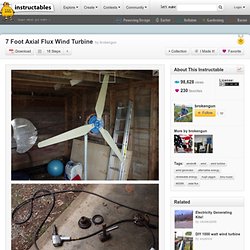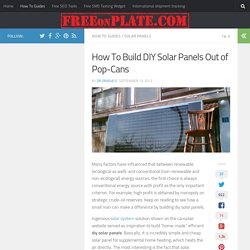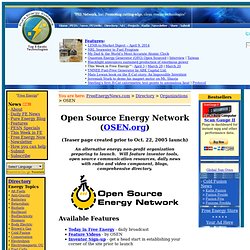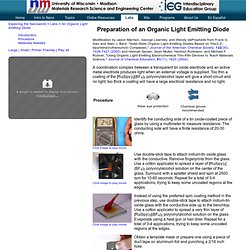

Thermal Mass Homes. Solar. Useful ebooks. 7 Foot Axial Flux Wind Turbine. This instructable documents the process of my single rotor wind turbine.

2KW DIY Solar panels made of pop cans for home solar heating. At the end, the solar absorber is painted black and placed in the diy solar panels casing.

The casing is covered with plexiglass that we attach to the frame and thoroughly corked with silicone. Polycarbonate / plexiglass is slightly convex in order to gain greater strength. You can see installed solar absorber without plexiglass in picture 18. Complete solar collector is shown on Picture 19, and finally, installed solar system can be seen in Picture 20. The following page shows complete specification of parts and material needed for building diy solar panels. Open Source Energy Network (OSEN) (Teaser page created prior to Oct. 22, 2005 launch) An alternative energy non-profit organization preparing to launch.

Will feature inventor tools, open source communication resources, daily news with radio and video component, blogs, comprehensive directory. Available Features Official Websites. An Organic Light Emitting Diode. </p><p><h2>ENABLE JAVASCRIPT<br />TO PLAY MOVIES<br />OF EACH STEP</h2> Modification by Jason Marmon, George Lisensky, and Wendy deProphetis from Frank G.

Gao and Allen J. Bard, "Solid-State Organic Light-Emitting Diodes Based on Tris(2,2'-bipyridine)ruthenium(II) Complexes," Journal of the American Chemical Society, 122(30), 7426-7427 (2000) and Hannah Sevian, Sean Muller, Hartmut Rudmann, and Michael F. Rubner, "Using Organic Light-Emitting Electrochemical Thin-Film Devices to Teach Materials Science," Journal of Chemical Education, 81(11), 1620 (2004). Open Source Washing Machine Project. Open Source Jacquard Loom Project. Filabot Personal Filament Maker for 3D Printers - Desktop Extruding System – Environmentally Friendly. DIY smart materials. Wood gas. Wood gas is a syngas fuel which can be used as a fuel for furnaces, stoves and vehicles in place of gasoline, diesel or other fuels.

During the production process biomass or other carbon-containing materials are gasified within the oxygen-limited environment of a wood gas generator to produce hydrogen and carbon monoxide. These gases can then be burnt as a fuel within an oxygen rich environment to produce carbon dioxide, water and heat. Small Earthbag Domes. Green Home Building: Index. Arizona Shop Structure. Hemp Construction using Natural Lime from St Astier. Hemp is a natural material suitable for making light weight insulating mortars.

Lime kiln. Limestone. Limestone makes up about 10% of the total volume of all sedimentary rocks.

The solubility of limestone in water and weak acid solutions leads to karst landscapes, in which water erodes the limestone over thousands to millions of years. Most cave systems are through limestone bedrock. Limestone has numerous uses: as a building material, as aggregate for the base of roads, as white pigment or filler in products such as toothpaste or paints, and as a chemical feedstock. The first geologist to distinguish limestone from dolomite was Belsazar Hacquet in 1778.[1] Description[edit] Adobe. Www.greenspec.co.uk/blocks.php. Waste or Resource? Indigenous Uses of Cow Dung and Urine in Rural India. The respect and regard paid to cows in India is well known, but the importance to rural Indians of the dung and urine of this sacred animal is often ignored.

RBE10K Project Participants - The Resource-Based Economic Model Crowdsourced Knowledgebase. Thermal mass. The benefit of thermal mass is shown in this comparison of how heavy and light weight constructions affect internal temperature Thermal mass is a concept in building design that describes how the mass of the building provides "inertia" against temperature fluctuations, sometimes known as the thermal flywheel effect.[1] For example, when outside temperatures are fluctuating throughout the day, a large thermal mass within the insulated portion of a house can serve to "flatten out" the daily temperature fluctuations, since the thermal mass will absorb thermal energy when the surroundings are higher in temperature than the mass, and give thermal energy back when the surroundings are cooler, without reaching thermal equilibrium.

This is distinct from a material's insulative value, which reduces a building's thermal conductivity, allowing it to be heated or cooled relatively separate from the outside, or even just retain the occupants' thermal energy longer. Background[edit] . Passive solar building design. Elements of passive solar design, shown in a direct gain application In passive solar building design, windows, walls, and floors are made to collect, store, and distribute solar energy in the form of heat in the winter and reject solar heat in the summer. This is called passive solar design or climatic design because, unlike active solar heating systems, it doesn't involve the use of mechanical and electrical devices.[1] The key to designing a passive solar building is to best take advantage of the local climate.
Elements to be considered include window placement and glazing type, thermal insulation, thermal mass, and shading.[2] Passive solar design techniques can be applied most easily to new buildings, but existing buildings can be adapted or "retrofitted". Passive energy gain[edit] Passive solar technologies use sunlight without active mechanical systems (as contrasted to active solar). Earthship Biotechure: Green Infrastructure that is Energy, Food, and Water Sustainable. Posted by One Community on Saturday, January 14, 2012 · 2 Comments.

Earthship-illustration1.jpg (728×440) R.E.A.C.H. Earthship Community, a pictorial. How I built an electricity producing Solar Panel. Several years ago I bought some remote property in Arizona. I am an astronomer and wanted a place to practice my hobby far away from the sky-wrecking light pollution found near cities of any real size. In my attempt to escape city slicker yuppies (you know the kind, the ones that like to blab loudly on their cell phone while they work on some business administration degree in a cyber cafe somewhere in Trendyland.) and their light pollution, I found a great piece of remote property.
The problem is, it's so remote that there is no electric service available. That's not really a problem. No electricity equals no light pollution. I built a wind turbine to provide some power on the remote property. Www.applied-sciences.net/library/data/zoetrope-wind-turbine.pdf. Applied Sciences. Bright and shiny renewable energy. Homemade Rainwater Collection System. eGroupHub.
How Rain Harvesting Works. Ecotivity. Maslow's_hierarchy_of_needs.png (1717×1124) Www.Fuelless.com Fuelless Engine Plans. Lime mortar. Sustainable Green Buildings - Earthship Biotecture. Welkom bij Earthship Belgium vzw. What is Sustainable Building?